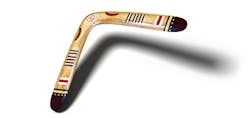What Goes Around Comes Around
For some reason, I get a kick out of seeing the cyclicality of technology—what I consider kind of a chicken-and-egg conundrum. For example, today's microprocessors are smaller and faster than ever, packing more transistors and functionality into the allotted space than one might have thought imaginable. But they're also more complex than ever, leaving chip designers scratching their heads about the best way to manage the massive amounts of data that need to be processed to turn that design into reality.
But guess what? They can use a whole slew of those complex chips (because they're cheaper than ever, too) and run them all in parallel to crunch the data in a relatively reasonable amount of time. In other words, the complex chips are enabling the manufacture of more complex chips.
Those complex chips are finding their way increasingly into the automation—say, in the form of multicore processors in embedded industrial PCs—that is needed to run the fab equipment making the chips. Which is the chicken, and which is the egg?
"A lot of people with dual core will run logic and motion on one core, and HMI software on another," notes Graham Harris, president of Beckhoff Automation. "You can manage visualization and all your machine control, and get the value of two PCs inside one. As we move forward, and the software gets better, you can put video on another core. You may put simulation on another core, or high-speed measurement calculations. It will depend upon the creativity of the software."
My fascination for all things cyclical really takes hold when I tour a supplier's manufacturing facility. I know that what I'm ostensibly there to see is said supplier's impressive manufacturing capabilities for its cool new products. But what I'm primarily thinking is, "Hmm, who makes this machine, and I wonder what's inside it." As it turns out, the supplier is usually more than happy to tell me what's inside it because they often make a point of specifying their own automation for the equipment.
At a tour earlier this year of B&R Automation's facilities in Eggelsberg, Austria, we learned that about 2,500 machine builders buy products every month from B&R. Obviously, some of those machine builders also have B&R as a customer. A closer look at the SMT production line, for example, showed that it was B&R's own controllers on the test line, testing about 400,000 PCBs a month. And equipment throughout the factory was loaded with B&R interfaces.
Control Design's October 2011 OEM Spotlight grew out of a recent visit to Siemens Automation's newly renovated plant in West Chicago, Ill., where the company spent about $10 million to overhaul its production. Siemens was showing off its new motor control centers (MCCs) and its upgraded custom manufacturing capabilities, while I just kept thinking, "Who is this Finn-Power that seems to have made all the equipment in the place?"
You can read "Automation for the Automater" to find out more about who Finn-Power (now Prima Power) is, but the key for Siemens was that Prima Power was able to give them a completely integrated tool set, making the manufacturing process more automated and customizable. It helped that Siemens had a longstanding relationship with the machine builder, having bought its first flexible machine system (FMS) from Finn-Power more than 15 years earlier.
And, you guessed it, the machines are all full of Siemens automation. Prima Power uses more than 1,000 different Siemens parts in its equipment. "We've used their controls for a long time," says Mike Stock, vice president of sales for Prima Power. "In our newer equipment, the servo electric drives are Siemens drives." The servo electric drives replace hydraulic drives in some of the machines, eliminating heat and vibration that compromised accuracy.
"The more automated the functionality of the equipment, the more highly Siemens it is," says Deron Jackson, plant manager for Siemens' West Chicago facility. In turn, the improved accuracy of the equipment is enabling Siemens to turn out MCCs faster and more cost-effectively.
So which came first, the chicken or the egg? Either way, technology begets technology begets technology.


